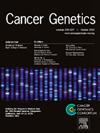75.将拷贝数变异异质性作为癌症分层分类中生物一致性的衡量标准
IF 2.1
4区 医学
Q4 GENETICS & HEREDITY
引用次数: 0
摘要
癌症是一种异质性疾病,具有细胞生长异常和消耗性生长的统一特征,正常细胞功能的失调是由任何器官细胞(可能是任何器官)的基因组突变积累引起的。恶性肿瘤在诊断时会出现不同程度的体细胞基因组变异。在不同类型的基因组变异中,拷贝数变异(CNV)是一类独特的、几乎无处不在的结构变异。然而,细胞表型的高度异质性和肿瘤微环境的动态可塑性使得肿瘤分类成为一项艰巨而复杂的任务,需要在分类和个体化、"个性化 "特征定义之间取得平衡。为了弄清分类如何反映生物学事实,我们基于progenetix数据库中512个分级癌症实体的97142个样本的跨基因组CNV图谱,对分类层次中不同级别的样本间基因组异质性进行了荟萃分析。使用个体癌症样本的大型数据集可以更深入地探索特定诊断概念之间和内部的基因组肿瘤异质性。在这项研究中,我们应用分层聚类技术,通过基于 CNV 事件的汉明不相似性的精细度量来量化癌症实体之间的异质性。研究结果指出了癌症实体的共同/特异 CNV 模式和潜在亚型,这将有助于改善患者分层和当前的癌症分类。本文章由计算机程序翻译,如有差异,请以英文原文为准。
75. Copy number variation heterogeneity as the measure for biological consistency in hierarchical cancer classifications
Cancers are heterogeneous diseases with unifying features of abnormal and consuming cell growth, where the deregulation of normal cellular functions is initiated by the accumulation of genomic mutations in cells of - potentially - any organ. At diagnosis malignant tumors present with patterns of somatic genome variants on diverse levels of heterogeneity. Among the different types of genomic alterations, copy number variants (CNV) represent a distinct, near-ubiquitous class of structural variants. Cancer classifications such as the National Cancer Institute Thesaurus (NCIt) provide large sets of hierarchical cancer classification vocabularies and promote data interoperability and ontology-driven computational analysis.
However, high heterogeneity in cellular phenotypes and dynamic plasticity of tumor microenvironments make tumor categorization a demanding and complicated task with the need to balance between categorical classifications and individual, 'personalized' feature definitions. To find out how categorical classifications reflect biological facts, we conducted a meta-analysis of inter-sample genomic heterogeneity at different levels of the classification hierarchies based on genome-spanning CNV profiles from 97,142 individual samples across 512 hierarchical cancer entities in the progenetix database. The use of a large data set of individual cancer samples allows for a greater exploration of genomic tumor heterogeneity between and inside given diagnostic concepts. With this study, we applied hierarchical clustering to quantify the heterogeneity among cancer entities through a refined measure of hamming dissimilarity based on CNV events. The results point out common/specific CNV patterns and potential subtypes of cancer entities, which will help in the improvement of patient stratification and current cancer classification.
求助全文
通过发布文献求助,成功后即可免费获取论文全文。
去求助
来源期刊

Cancer Genetics
ONCOLOGY-GENETICS & HEREDITY
CiteScore
3.20
自引率
5.30%
发文量
167
审稿时长
27 days
期刊介绍:
The aim of Cancer Genetics is to publish high quality scientific papers on the cellular, genetic and molecular aspects of cancer, including cancer predisposition and clinical diagnostic applications. Specific areas of interest include descriptions of new chromosomal, molecular or epigenetic alterations in benign and malignant diseases; novel laboratory approaches for identification and characterization of chromosomal rearrangements or genomic alterations in cancer cells; correlation of genetic changes with pathology and clinical presentation; and the molecular genetics of cancer predisposition. To reach a basic science and clinical multidisciplinary audience, we welcome original full-length articles, reviews, meeting summaries, brief reports, and letters to the editor.
 求助内容:
求助内容: 应助结果提醒方式:
应助结果提醒方式:


